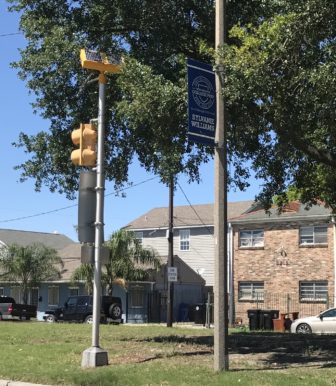Most of the city’s school-zone lights are working, and they’re sporting a new, bright yellow feature — photo enforcement signs.
In late April and early May, The Lens checked every school-zone light in the city and found 82 percent worked properly.
That’s the highest percentage we’ve found in five surveys. It’s much better than the first time we checked in January 2015, when just two out of five worked properly.
The first three times we checked, many lights didn’t flash at all or blinked quickly in unison to warn the battery was almost dead. Some of the solar panels were pointed the wrong direction or were shaded by trees, which can prevent the batteries from charging.
The improvement coincides with Mayor Mitch Landrieu’s expansion of the city’s traffic camera program, which is focused on school zones.
When we surveyed the lights last fall, 79 percent worked properly. Soon after, Landrieu announced the city would nearly double the number of cameras that issue tickets for speeding and running red lights, with an emphasis on school zones.
There are still some problems. For instance, the city turned off two lights although students are still in the building.
We found the same thing at two schools last fall. The city turned the lights back on after we told them.
But in general, more lights are working, fewer show low battery warnings, and most of the solar panels point in the right direction.
Cameras spur action and reaction
Cars slowed to a crawl a recent Friday afternoon as they approached the flashing lights on Martin Luther King Jr. Blvd. in front of Sylvanie Williams College Prep.
The two cars plastered with “PHOTO ENFORCEMENT,” in the same blue italicized lettering as NOPD cruisers, may have had something to do with it.
Leaning against the pole was a sign cautioning drivers about the cameras.
“People drive way too fast. … Are they going to wait for someone to get hurt before they fix it?”—Daniela Marx, whose child attends International School of Louisiana
There were already cameras at about a quarter of the city’s school-zone lights. When the additional 45 are installed, about 60 percent of the lights will have cameras. In addition, the city has 10 car-mounted cameras that can be set up anywhere.
The school speed limit is 20 mph from 7 to 9 a.m. and 2:45 to 4:45 p.m. when school is in session. It applies even when the lights aren’t working. But the city doesn’t issue tickets if they’re broken, so it has an incentive to keep them functioning.
City spokeswoman Erin Burns said the mobile units issued 7,802 citations in school zones from Feb. 7 to May 4.
But not all city officials are on board with the additional cameras. City Councilwoman LaToya Cantrell said she’s concerned about Landrieu’s plan to use them to bring in more revenue, in part because it would punish working-class residents.
She said the city should use other “evidence-based” methods to increase safety in school zones, and it should make sure all the lights work.
The city hasn’t shown that traffic cameras make streets safer, and studies from across the country are inconclusive. The city’s camera contract requires traffic studies at each location before the cameras are installed, but neither the city nor the traffic camera company could produce them.
“If the cameras really increase safety, then show us,” Cantrell said. “The study needs to be conducted, discussed and then the policy should be fully reviewed with public input.”
Are the lights working at your child’s school?
A few trouble spots

While more of the lights are working than before, we found some problems. One is at International School of Louisiana’s campus in the Lower Garden District, where Daniela Marx’s daughter is in fifth grade.
The lights on one side of the school, on Camp and Coliseum streets, worked when we checked. The light on the other side, on Magazine Street, has been persistently broken, she said.
“We’ve been there six years and it still doesn’t work properly,” Marx said.
She said the light worked for a week at the beginning of the school year. The Lens has checked it five time since the beginning of 2015 and has never observed it working.
“People drive way too fast,” she said. “Are they going to wait for someone to get hurt before they fix it?”
A study done in Washington state found flashing lights in school zones spur drivers to slow down.
Even if the light isn’t working, the speed limit applies. “I think people think that because the light doesn’t work that there is no school zone,” Marx said.
Hurricane recovery, independent schools present challenges
In a city with more than 80 public schools, it can be tricky to keep track of where school zone lights should be and when they should flash.
Most of the city’s schools are charters that operate independently. Charter schools, which are publicly funded but privately run, make their own staffing decisions and set their own calendars.
That presents some challenges to the city. School-zone lights are enforceable only on days when students are in school.
And each year, some schools move as buildings are repaired and renovated.
Last fall, the lights were off at two schools even though elementary students were there. The city had turned them off when prior schools moved out. We alerted the city, and it turned them back on.
Last month, the lights in front of Paul Habans Elementary School on MacArthur Avenue on the West Bank were off. Burns said the light was deactivated because the building was empty, but Crescent City Schools still has students there.
If so, she said, the lights would be restored.
The city also deactivated the lights on Michoud Boulevard. But Einstein Charter School occupies the campus near with those lights.
Meanwhile, another light on Dwyer was working. That was a mistake, Burns said, and it will be turned off.

